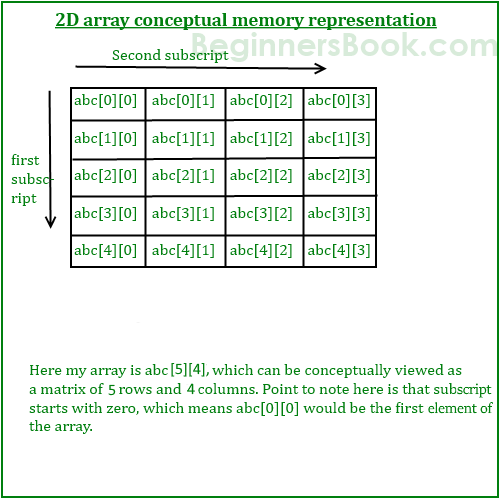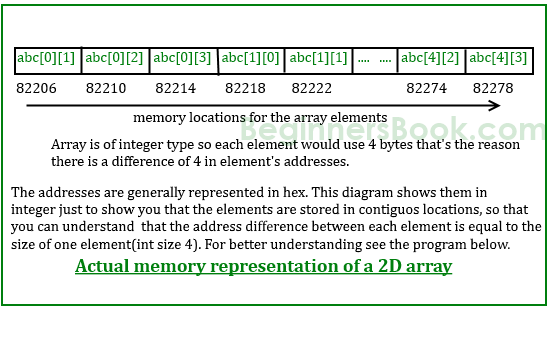Arrays Part2
Two dimensional (2D) arrays
Simple Two dimensional(2D) Array Example
For now don’t worry how to initialize a two dimensional array, we will discuss that part later. This program demonstrates how to store the elements entered by user in a 2d array and how to display the elements of a two dimensional array.
#include<stdio.h> int main(){ /* 2D array declaration*/ int disp[2][3]; /*Counter variables for the loop*/ int i, j; for(i=0; i<2; i++) { for(j=0;j<3;j++) { printf("Enter value for disp[%d][%d]:", i, j); scanf("%d", &disp[i][j]); } } //Displaying array elements printf("Two Dimensional array elements:\n"); for(i=0; i<2; i++) { for(j=0;j<3;j++) { printf("%d ", disp[i][j]); if(j==2){ printf("\n"); } } } return 0; }
Output:
Enter value for disp[0][0]:1 Enter value for disp[0][1]:2 Enter value for disp[0][2]:3 Enter value for disp[1][0]:4 Enter value for disp[1][1]:5 Enter value for disp[1][2]:6 Two Dimensional array elements: 1 2 3 4 5 6
Initialization of 2D Array
There are two ways to initialize a two Dimensional arrays during declaration.
int disp[2][4] = { {10, 11, 12, 13}, {14, 15, 16, 17} };
OR
int disp[2][4] = { 10, 11, 12, 13, 14, 15, 16, 17};
Although both the above declarations are valid, I recommend you to use the first method as it is more readable, because you can visualize the rows and columns of 2d array in this method.
Things that you must consider while initializing a 2D array
We already know, when we initialize a normal array (or you can say one dimensional array) during declaration, we need not to specify the size of it. However that’s not the case with 2D array, you must always specify the second dimension even if you are specifying elements during the declaration. Let’s understand this with the help of few examples –
/* Valid declaration*/ int abc[2][2] = {1, 2, 3 ,4 } /* Valid declaration*/ int abc[][2] = {1, 2, 3 ,4 } /* Invalid declaration – you must specify second dimension*/ int abc[][] = {1, 2, 3 ,4 } /* Invalid because of the same reason mentioned above*/ int abc[2][] = {1, 2, 3 ,4 }
How to store user input data into 2D array
We can calculate how many elements a two dimensional array can have by using this formula:
The array arr[n1][n2] can have n1*n2 elements. The array that we have in
the example below is having the dimensions 5 and 4. These dimensions
are known as subscripts. So this array has first subscript value as 5 and second subscript value as 4.
So the array abc[5][4] can have 5*4 = 20 elements.
To store the elements entered by user we are using two for loops, one of them is a nested loop. The outer loop runs from 0 to the (first subscript -1) and the inner for loops runs from 0 to the (second subscript -1). This way the the order in which user enters the elements would be abc[0][0], abc[0][1], abc[0][2]…so on.
#include<stdio.h> int main(){ /* 2D array declaration*/ int abc[5][4]; /*Counter variables for the loop*/ int i, j; for(i=0; i<5; i++) { for(j=0;j<4;j++) { printf("Enter value for abc[%d][%d]:", i, j); scanf("%d", &abc[i][j]); } } return 0; }
In above example, I have a 2D array abc of integer type. Conceptually you can visualize the above array like this:

However the actual representation of this array in memory would be something like this:

Pointers & 2D array
As we know that the one dimensional array name works as a pointer to the base element (first element) of the array. However in the case 2D arrays the logic is slightly different. You can consider a 2D array as collection of several one dimensional arrays.
So abc[0] would have the address of first element of the first row (if we consider the above diagram number 1).
similarly abc[1] would have the address of the first element of the second row. To understand it better, lets write a C program –
#include <stdio.h> int main() { int abc[5][4] ={ {0,1,2,3}, {4,5,6,7}, {8,9,10,11}, {12,13,14,15}, {16,17,18,19} }; for (int i=0; i<=4; i++) { /* The correct way of displaying an address would be * printf("%p ",abc[i]); but for the demonstration * purpose I am displaying the address in int so that * you can relate the output with the diagram above that * shows how many bytes an int element uses and how they * are stored in contiguous memory locations. * */ printf("%d ",abc[i]); } return 0; }
Output:
1600101376 1600101392 1600101408 1600101424 1600101440
The actual address representation should be in hex for which we use %p instead of %d, as mentioned in the comments. This is just to show that the elements are stored in contiguous memory locations. You can relate the output with the diagram above to see that the difference between these addresses is actually number of bytes consumed by the elements of that row.
The addresses shown in the output belongs to the first element of each row abc[0][0], abc[1][0], abc[2][0], abc[3][0] and abc[4][0].
Relationship Between Arrays and Pointers
A pointer is a variable whose value is the address of another variable, i.e., direct address of the memory location. Like any variable or constant, you must declare a pointer before using it to store any variable address. The general form of a pointer variable declaration is −
type *var-name;
Here, type is the pointer's base type; it must be a valid C data type and var-name is the name of the pointer variable. The asterisk * used to declare a pointer is the same asterisk used for multiplication. However, in this statement the asterisk is being used to designate a variable as a pointer. Take a look at some of the valid pointer declarations −
int *ip; /* pointer to an integer */ double *dp; /* pointer to a double */ float *fp; /* pointer to a float */ char *ch /* pointer to a character */
The actual data type of the value of all pointers, whether integer, float, character, or otherwise, is the same, a long hexadecimal number that represents a memory address. The only difference between pointers of different data types is the data type of the variable or constant that the pointer points to.
How to Use Pointers?
There are a few important operations, which we will do with the help of pointers very frequently. (a) We define a pointer variable, (b) assign the address of a variable to a pointer and (c) finally access the value at the address available in the pointer variable. This is done by using unary operator * that returns the value of the variable located at the address specified by its operand. The following example makes use of these operations −
#include <stdio.h> int main () { int var = 20; /* actual variable declaration */ int *ip; /* pointer variable declaration */ ip = &var; /* store address of var in pointer variable*/ printf("Address of var variable: %x\n", &var ); /* address stored in pointer variable */ printf("Address stored in ip variable: %x\n", ip ); /* access the value using the pointer */ printf("Value of *ip variable: %d\n", *ip ); return 0; }
When the above code is compiled and executed, it produces the following result −
Address of var variable: bffd8b3c Address stored in ip variable: bffd8b3c Value of *ip variable: 20
Example 1: Pointers and Arrays
#include <stdio.h>
int main() {
int i, x[6], sum = 0;
printf("Enter 6 numbers: ");
for(i = 0; i < 6; ++i) {
// Equivalent to scanf("%d", &x[i]);
scanf("%d", x+i);
// Equivalent to sum += x[i]
sum += *(x+i);
}
printf("Sum = %d", sum);
return 0;
}
When you run the program, the output will be:
Enter 6 numbers: 2 3 4 4 12 4 Sum = 29
Example 2: Arrays and Pointers
int main()
{
int x[5] = {1, 2, 3, 4, 5};
int* ptr;
// ptr is assigned the address of the third element
ptr = &x[2];
printf("*ptr = %d \n", *ptr); // 3
printf("*(ptr+1) = %d \n", *(ptr+1)); // 4
printf("*(ptr-1) = %d", *(ptr-1)); // 2
return 0;
}
When you run the program, the output will be:
*ptr = 3In this example, &x[2], the address of the third element, is assigned to the ptr pointer. Hence, 3 was displayed when we printed *ptr.
And, printing *(ptr+1) gives us the fourth element. Similarly, printing *(ptr-1) gives us the second element.
Comments
Post a Comment